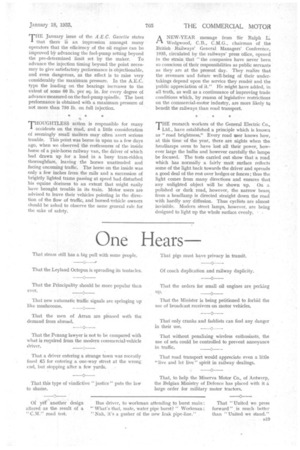T "January issue of the A.E.C. Gazette states that there i
Page 33

If you've noticed an error in this article please click here to report it so we can fix it.
an impression amongst many operators that the efficiency of the oil engine can be improvedb advancing the fuel-pump setting beyond the pre-determined limit set by the maker. To advance the injection timing beyond the point necessary to give satisfactory performance is objectionable, and even dangerous, as the effect is to raise very considerably the maximum pressure. In the A.E.C. type the loading on the bearings increases to the extent of some 60 lb. per sq. in. for every degree of advance measured on the fuel-pump spindle. The best performance is obtained with a maximum pressure of not more than 750 lb. on full injection.
THOUGHTLESS action is responsible for many accidents on the road, and a little consideration of seemingly small matters may often avert serious trouble. This point was borne in upon us a few days ago, when we observed the restlessness of the inside horse of a pair-horse railway van, the driver of which had drawn up for a load in a busy train-ridden thoroughfare, leaving the horses unattended and facing oncoming traffic. The horse on the inside was only a few inches from the rails and a succession of brightly lighted trams passing at speed had disturbed his equine doziness to an extent that might easily have brought trouble in its train. Motor users are advised to leave their vehicles pointing in the direction of the flow of traffic, and horsed-vehicle owners should be asked to observe the same general rule for the sake of safety. ANEW-YEAR message from Sir Ralph L. Wedgwood, C.B., C.M.G., chairman of the British Railways' General Managers' Conference, 1935, circulated by the railways' press office, opened in the strain, that "the companies have never been so conscious of their responsibilities as public servants as they are at the present day. They realize that the revenues and future well-being of their undertakings depend upon the service they render and the public appreciation of it." He might have added, in all truth, as well as a continuance of improving trade conditions which, by reason of legislative restrictions on the commercial-motor industry, are more likely to benefit the railways than road transport.
THE research workers of the General Electric Co., Ltd., have established a principle which is known as "road brightness." Every road user knows how, at this time of the year, there are nights when the headlamps seem to have lost all their power, however large the bulbs and however carefully the lamps be focused. The tests carried out show that a road which has normally a fairly matt surface reflects some of the light back towards the driver and spreads a good deal of the rest over hedges or fences ; thus the light comes from many directions and ensures that any unlighted object will be shown up. On a polished or dark road, however, the narrow beam, from a headlamp is directed straight down the road with hardly any diffusion. Thus cyclists are almost invisible. Modern street lamps, however, are being
designed to light up the whole surface evenly.




























































































